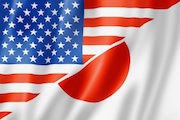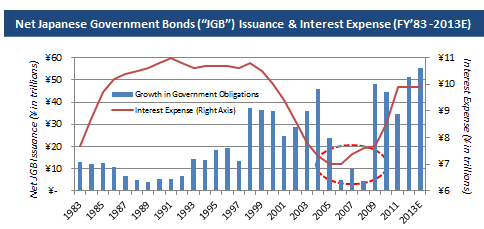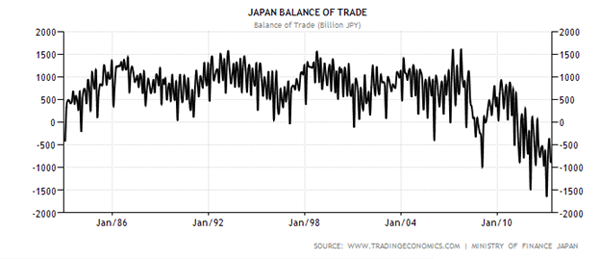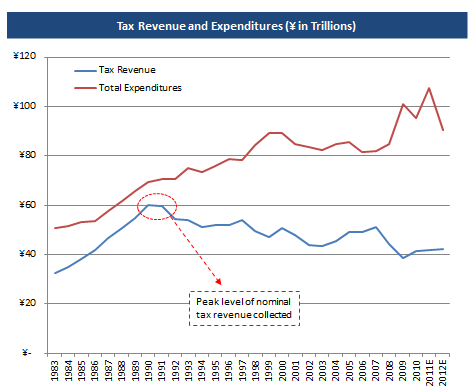In today’s article John Mauldin describes Japan’s economy as “a bug in search of a windshield” and when you look at their monetary situation you wonder how they could possibly have gone this long with the inevitable smash-up. John believes that 2013 is “the year of the windshield” for Japan. ~Tim McMahon, editor
Thoughts from the Frontline: Central Bankers Gone Wild.
By John Mauldin

In bullet-point fashion, let’s summarize the dilemma that faces Abe-san, Kuroda-san, and the other leaders of Japan.
- Japan is saddled with a yawning fiscal deficit that, if it were closed too quickly, would plunge the country into immediate and deep recession. The yen would strengthen, and Japan’s exports would once again be damaged. Such is the paradoxical outcome if you suddenly decide to live within your means when you have been on a spending binge. The Japanese annual budget deficit is close to 10% of GDP. For my US readers, think about what would happen next year if the government cut $1.6 trillion from our budget. [ed. note: Japan’s total debt in 2013 isJapan has a GDP that is now close to 500 trillion yen (give or take a few tens of trillions). Their most recent budget calls for Y92.6 trillion in spending, almost evenly divided between Y43.1 trillion financed from tax revenues and Y42.9 trillion from the issuance of new bonds, adding to Japan’s massive public-sector debt that already totals nearly Y1 quadrillion. Say that with a straight face: 1 quadrillion. And this massive debt is not a recent phenomenon: it has been accumulating for many years.Tax revenues have been going down for decades, as the country has been mired in no-growth deflation for 24 years. Revenues are now down to where they were in 1985. By way of comparison, US tax revenues in 1985 were $734 billion (or $1,174 billion in constant 2005 dollars). Last year, US revenues were $2,450 – that is, more than double the 1985 total. (taxpolicycenter.org)The following chart is courtesy of my friend and Japan expert Kyle Bass at Hayman Capital Management. If this were a stock, would you be a buyer?
- Japanese ten-year interest rates exploded from just above 30 basis points to over 1% at one point in the past month. The Bank of Japan (BOJ) intervened, but rates closed today at 0.85%. Note that they are still down from the 1.3% where they stood two years ago.
- It costs the Japanese government 24% of its revenues just to pay the interest on its debt at current rates. According to my friend Grant Williams (author of Things That Make You Go Hmmm…), if rates rise to just 2.2%, then it will take 80% of revenues to pay the interest. Even at the low current rates, the explosion in Japanese debt has meant that interest rate expense has risen from Y7 trillion to over Y10 trillion. Note in the chart below (also from Kyle) that the Japanese government is now issuing more in bonds than it pays in interest. Somewhere, Charles Ponzi is smiling.

Just for fun, here is a picture of Mr. Ponzi writing a check (courtesy of Geert Noels).
- For 20-plus years, Japanese nominal GDP has barely risen. If your nominal GDP stagnates and you are running large deficits every year, then your debt-to-GDP ratio rises. For Japan, the ration will be a staggering, never-before-seen 245% this year.
- The only way you can lower the rate of debt-to-GDP expansion – and perhaps convince investors to continue to buy your bonds – is to increase your nominal GDP while slowly lowering your deficit over time until the increase in your debt is less than the nominal growth of your economy.
- After years of running trade surpluses, Japan is now running a trade deficit. Basic economic accounting tells us that for Japan to get to its goal of sustainability, it absolutely must have a trade surplus. And as deep a hole as Japan is in, it needs seriously large trade surpluses. Like back in the good old days of only a few years ago. Not to mention that the country’s current account surplus is down by over half from its peak in 2007 and back to where it was 20 years ago. The trend is ugly.

- There are only two ways to get nominal growth. You can get real growth or you can create inflation. There are not many things that you can get Hayek and Keynes and every other economist to agree on, but this one thing is the universal answer to your fiscal problems: Growth, with a capital G. That is the remedy put forth by every economist and every politician : “We need to grow our way out of the crisis.” But there are two problems as Japan tries to get to growth.
Problem #1: Your nation is aging, and internal consumer spending is not going to be a source of real growth. You have to talk like that can happen, but you know it is just not all that realistic. You have been trying for 20 years to get your country to spend, and people are just not up to it. What you really need is for your export base to get with the program and massively increase its sales to the rest of the world. In fact, that is your only real option. And one of the easiest ways to do that is to drive down the value of your currency, especially against the currencies of competitor nations. That boost in exports can help relieve your chronic excess productive capacity and maybe, possibly, hopefully, engender a labor shortage and drive up the cost of labor, which will help stimulate inflation.
Problem #2: You are mired in deflation and have been for 20 years. Since there is no natural source of inflation in Japan – a nation of savers and an increasingly elderly population –you have to create inflation by increasing the prices of your imports. And the way to increase those prices is to drive down the value of your currency, especially against the dollar and the euro.
Hmmm, we see a possible strategy emerging here.
To read the rest of this article from Thoughts from the Frontline – please click here.
See Also:
- How the Golden Reset Button Could Drive the Price of Gold to $20,000.
- Germany Will Exit Euro
- Bank Runs Can’t Happen- Right?
- Top U.S. Trading Partners
- Beijing’s Pollution Alarms Neighbors
Recommended by Amazon:
- The Bubble Economy: Japan’s Extraordinary Speculative Boom of the ’80s and the Dramatic Bust of the ’90s
- The Holy Grail of Macroeconomics: Lessons from Japan’s Great Recession
- Reimagining Japan: The Quest for a Future That Works
- How an Economy Grows and Why It Crashes– ‘If you feel you want to get a decent grasp of free-market economics…this book
is the perfect place to start.’ - Economics in One Lesson: The Shortest and Surest Way to Understand Basic Economics By Henry Hazlett


